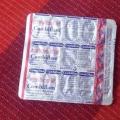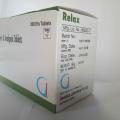Home / Categories / D-PAIN

D-PAIN
(20TX10S)
IBUPROFEN-400MG
PARACETAMOL-325MG
NSAIDS-ANTIPYRETIC/ANALGESICS
ASIAN PHARMACEUTICALS-NAISA-DIVISION
Product Details
Ibuprofen
A to Z Drug Facts
| Ibuprofen |
| (eye-BYOO-pro-fen) |
Advil, Advil Liqui-Gels, Advil Migraine, Children's Advil, Children's Motrin, Genpril, Haltran, Infant's Motrin, Junior Strength Advil, Junior Strength Motrin, Menadol, Midol Maximum Strength Cramp Formula, Motrin, Motrin IB, Motrin Migraine Pain, Nuprin, PediaCare Fever, Pediatric Advil Drops,  Actiprofen, Alti-Ibuprofen, Apo-Ibuprofen, Novo-Profen, Nu-Ibuprofen Actiprofen, Alti-Ibuprofen, Apo-Ibuprofen, Novo-Profen, Nu-Ibuprofen |
| Class: Analgesic/NSAID |
 Action Decreases inflammation, pain, and fever, probably through inhibition of cyclooxygenase activity and prostaglandin synthesis.
Action Decreases inflammation, pain, and fever, probably through inhibition of cyclooxygenase activity and prostaglandin synthesis.
 Indications Relief of symptoms of rheumatoid arthritis, osteoarthritis, mild-to-moderate pain, primary dysmenorrhea, reduction of fever. Unlabeled use(s): Symptomatic treatment of juvenile rheumatoid arthritis, sunburn, resistant acne vulgaris.
Indications Relief of symptoms of rheumatoid arthritis, osteoarthritis, mild-to-moderate pain, primary dysmenorrhea, reduction of fever. Unlabeled use(s): Symptomatic treatment of juvenile rheumatoid arthritis, sunburn, resistant acne vulgaris.
 Contraindications Hypersensitivity to aspirin, iodides, or any other NSAID.
Contraindications Hypersensitivity to aspirin, iodides, or any other NSAID.
Rheumatoid Arthritis and Osteoarthritis
Adults: PO 300 to 800 mg tid to qid, not to exceed 3.2 g/day.
Mild-to-Moderate Pain
ADULTS: PO 400 mg q 4 to 6 hr prn.
Primary Dysmenorrhea
ADULTS: PO 400 mg q 4 hr prn.
Juvenile Arthritis
CHILDREN: PO 30 to 40 mg/kg/day in 3 to 4 divided doses.
Fever Reduction
CHILDREN 1 to 12 yr: £ 39.2° C (102.5° F) recommended dose PO 5 mg/kg; > 39.2° C (102.5° F) recommended dose PO 10 mg/kg; maximum daily dose 40 mg/kg.
OTC Use (Minor Aches/Pains, Dysmenorrhea, Fever Reduction)
PO 200 mg q 4 to 6 hr. Do not exceed 1.2 g in 24 hr or take for pain for > 10 days or for fever for > 3 days, unless directed by physician. Use smallest effective dose.
Beta-blockers: Antihypertensive effect may be decreased. Digoxin: Ibuprofen may increase digoxin serum levels. Lithium: May increase lithium levels. Loop diuretics: Diuretic effects may be decreased. Methotrexate: May increase methotrexate levels. Warfarin: May increase risk of gastric erosion and bleeding.
 Lab Test Interferences None well documented.
Lab Test Interferences None well documented.
CV: Peripheral edema; water retention; worsening or precipitation of CHF. CNS: Dizziness; lightheadedness; drowsiness; vertigo; headaches; aseptic meningitis. EENT: Visual disturbances; photophobia; tinnitus. GI: Gastric distress; occult blood loss; diarrhea; vomiting; nausea; heartburn; dyspepsia; anorexia; constipation; abdominal distress/cramps/pain; flatulence; indigestion; GI tract fullness. GU: Menometrorrhagia; hematuria; cystitis; acute renal insufficiency; interstitial nephritis; hyperkalemia; hyponatremia; renal papillary necrosis. DERM: Rash; pruritus; erythema. OTHER: Muscle cramps.
Pregnancy: Pregnancy category undetermined. Lactation: Undetermined. Children: Safety and efficacy not established. Elderly: Increased risk of adverse reactions. GI effects: Serious GI toxicity (eg, bleeding, ulceration, perforation) can occur at any time, with or without warning symptoms. Renal effects: Increased risk of dysfunction in patients with preexisting renal disease.
| PATIENT CARE CONSIDERATIONS |
|
- Give medication soon after meals or with food, milk, or antacids to minimize GI irritation.
- Obtain complete patient history, including drug history and any known allergies.
- Notify physician if visual changes or indications of GI distress or liver or renal impairment occur.
- Monitor patient's cardiac status: BP, pulse (quality and rhythm), edema, tachycardia, palpitations.
- Assess renal function before and during therapy. Serum creatinine, creatinine clearance, and BUN should be monitored in patients with renal impairment.
- Document any changes in liver function (AST, ALT), eye examinations and Hgb and Hct in patients on long-term therapy.
- Notify physician if indigestion, epigastric pain, unusual bleeding or bruising, or dark tarry stools occur.
|
||||
- Tell patient to take medication soon after meals or with food, milk, or antacids.
- Tell patient to avoid alcohol and medications containing aspirin, such as cold remedies.
- Advise patient to discontinue drug and notify physician if any of the following occur: Persistent GI upset or headache, skin rash, itching, visual disturbances, black stools, weight gain or edema, changes in urine pattern, joint pain, fever, blood in urine.
- Instruct patient not to take otc preparation for > 3 days for fever and > 10 days for pain and to notify physician if condition does not improve.
- Advise patient that drug may cause drowsiness and to use caution while driving or performing other tasks requiring mental alertness.
Books@Ovid
Copyright © 2003 Facts and Comparisons
David S. Tatro
A to Z Drug Facts
Acetaminophen (N-Acetyl-p-Aminophenol; APAP)
A to Z Drug Facts
| Acetaminophen (N-Acetyl-p-Aminophenol; APAP) |
| (ass-cet-ah-MEE-noe-fen) |
Acephen, Apacet, Arthritis Pain Formula Aspirin Free, Aspirin Free Anacin Maximum Strength, Bansesin, Children's Dynafed Jr., Children's Feverall, Children's Mapap, Children's Silapap, Children's Tylenol, Dapa, Datril Extra-Strength, Dolanex, Extra Strength Dynafed E.X., Feverall Sprinkle Caps, Genapap Extra Strength, Genebs, Halenol, Infants' Silapap, Junior Strength Panadol, Liquiprin, Mapap Extra Strength, Mapap Infant Drops, Mapap Regular Strength, Maranox Meda Cap, Myapap, Oraphen-PD, Panadol, Panex, Phenaphen, Redutemp, Ridenol, Snaplets-FR, Tapanol Extra Strength, Tempra, Tylenol, Tyenol Extended Relief, Tylenol Extra Strength Geltabs, Tylenol Infants' Drops, Tylenol Junior Strength, Uni-Ace,  Abenol, A.F. Anacin, Apo-Acetaminophen, Atasol, Children's Acetaminophen, Children's Chewable Acetaminophen, Extra Strength Acetaminophen, Pediatrix, PMS-Acetaminophen, Regular Strength Acetaminophen, Tempra, 222AF, Tylenol Abenol, A.F. Anacin, Apo-Acetaminophen, Atasol, Children's Acetaminophen, Children's Chewable Acetaminophen, Extra Strength Acetaminophen, Pediatrix, PMS-Acetaminophen, Regular Strength Acetaminophen, Tempra, 222AF, Tylenol |
| Class: Analgesic/antipyretic |
 Action Inhibits prostaglandins in CNS but lacks anti-inflammatory effects in periphery; reduces fever through direct action on hypothalamic heat-regulating center.
Action Inhibits prostaglandins in CNS but lacks anti-inflammatory effects in periphery; reduces fever through direct action on hypothalamic heat-regulating center.
 Indications Relief of mild-to-moderate pain; treatment of fever. Unlabeled use(s): Pain and fever prophylaxis after vaccination.
Indications Relief of mild-to-moderate pain; treatment of fever. Unlabeled use(s): Pain and fever prophylaxis after vaccination.
 Contraindications Standard considerations.
Contraindications Standard considerations.
ORAL
ADULTS: PO 325 to 650 mg prn q 4 to 6 hr or 1 g 3 to 4 times/day. Do not exceed 4 g/day. CHILDREN: PO 10 to 15 mg/kg dose prn q 4 to 6 hr; do not exceed 5 doses/24 hr.
SUPPOSITORIES
ADULTS: PR 650 mg q 4 to 6 hr; do not exceed 6 suppositories/24 hr. CHILDREN: 3–6 YR: PR 120 mg q 4 to 6 hr; do not exceed 720 mg/24 hr. CHILDREN: 6–12 YR: PR 325 mg q 4 to 6 hr; do not exceed 2.6 g/24 hr.
Ethanol: Chronic excessive use may increase risk of hepatotoxicity. Hydantoins, sulfinpyrazone: May decrease therapeutic effect of APAP; concomitant long-term use may increase risk of hepatotoxicity.
 Lab Test Interferences With Chemstrip, bG Dextrostix, Visidex II home blood glucose measurement systems, drug may cause > 20% decrease in mean glucose.
Lab Test Interferences With Chemstrip, bG Dextrostix, Visidex II home blood glucose measurement systems, drug may cause > 20% decrease in mean glucose.
HEMA: Hemolytic anemia; neutropenia; leukopenia; pancytopenia; thrombocytopenia. HEPA: Jaundice. OTHER: Hypoglycemia; allergic skin eruptions or fever.
Pregnancy: Category B. Lactation: Excreted in breast milk. Hepatic impairment: Chronic alcoholics should not exceed 2 g/day. Persistent pain or fever: May indicate serious illness. Physician should be consulted.
| PATIENT CARE CONSIDERATIONS |
|
- Administer with water 30 min before or 2 hr after meals.
- Store tablets and capsules at room temperature in tightly closed container. Refrigerate suppositories. Refrigeration of elixir improves palatability.
- Obtain patient history, including drug history and any known allergies.
- Assess for pain and fever before and 1 to 2 hr after administration.
- Assess serum glucose and liver enzyme levels before long-term therapy.
|
||||
- Instruct family to consult physician for use in children < 3 yr and, not to continue taking drug > 5 days unless advised by physician.
- Instruct adult patients not to continue taking drug > 10 days for pain or 3 days for fever.
- Instruct patient/family to contact physician if pain or fever (> 103°F) persists > 3 days.
- Advise diabetic patients to use sugar-free form of drug.
Books@Ovid
Copyright © 2003 Facts and Comparisons
David S. Tatro
A to Z Drug Facts
 Route/Dosage
Route/Dosage Interactions
Interactions Adverse Reactions
Adverse Reactions Precautions
Precautions Administration/Storage
Administration/Storage Assessment/Interventions
Assessment/Interventions Patient/Family Education
Patient/Family Education

